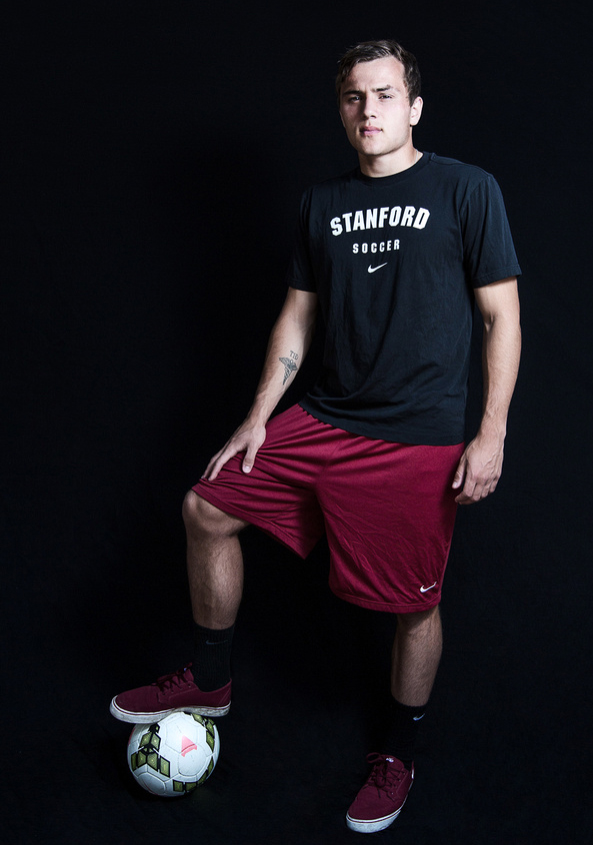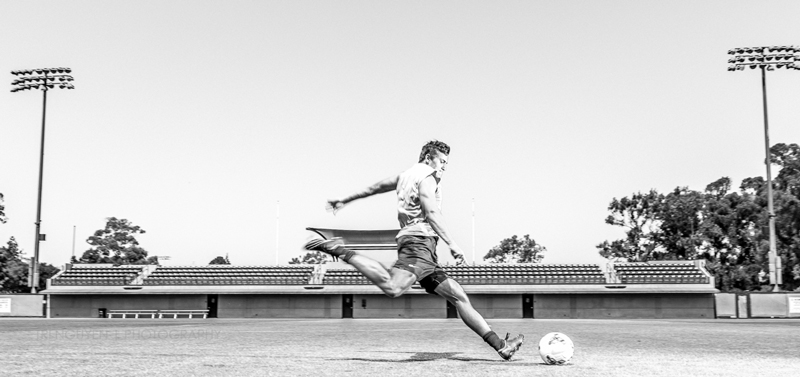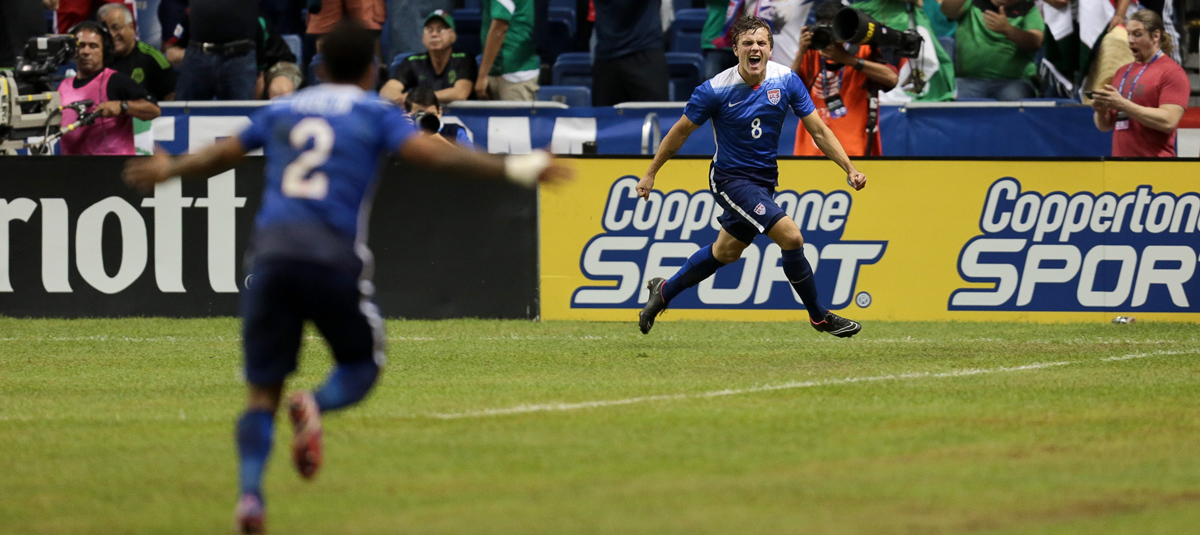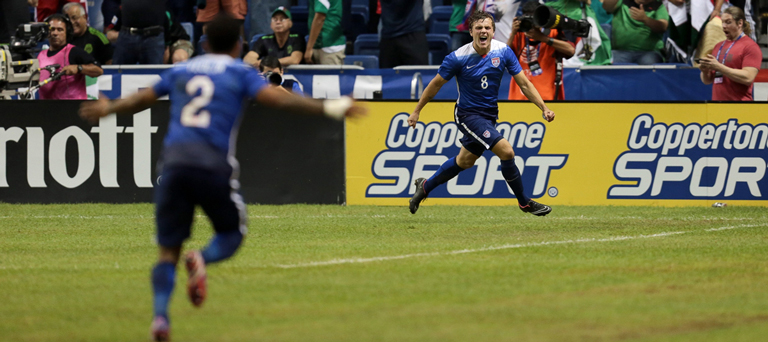How big was the second-half goal that sparked the United States national team to a 2-0 victory over Mexico on April 15? It resonated across campuses throughout the country, in places where coaches for a generation have fought the notion that the elite young player benefits more from bypassing college and heading straight for the pros.
Morris, a Stanford sophomore All-American, provided a convincing counter argument. Here was a player thriving in the college environment, to the point where he could put on a U.S. national team kit, score a goal in front of 64,000 fans, and thrust his fist into the air while being mobbed by teammates.
Barely three weeks after his goal in San Antonio’s Alamodome, Morris was approached by a UC Davis player after a spring match.
“Thank you,” the player said. “You’re representing all of us. Keep going, keep working hard.”
Morris was a little stunned.
“I think it’s tough to support someone if those are your goals too, you know,” Morris said. “That was really cool to say that.”
If others aren’t saying it, they should be thinking it.
As soccer continues to grow, the feeling is that for the U.S. to lift itself even higher internationally, it needs to match the European model where young players are plucked from local clubs in their teens and inserted into a professional team’s youth system. Soccer, in this model, trumps education.
In no other country do education and athletics go hand-in-hand, and it’s been successful partnership in every major U.S. sport, both in level of play and the maturation of the individual. Those differences, seen as positives for so many years in the soccer community, are largely viewed differently now. Major League Soccer fired the first shot by creating the Project-40 program in 1998 that allowed domestic teen-age players to skip college and sign pro contracts. Now, it’s not uncommon for young players to head straight to Europe, or to academies in the growing MLS system.

The arguments against college soccer are not enough matches, or the competition isn’t good enough. As the first voices expressed these opinions, others followed blindly or without taking a closer look.
“College soccer is serving an ongoing battle every day to be recognized for how positive it is,” Stanford coach Jeremy Gunn said. “The rest of the world operates on a model when people generally leave school at 16. And the rest of the world also creates a very large scrap heap of young men who don’t make the grade. And those who do are left after one contract with no qualifications and no great opportunities.
“In more traditional sports, America doesn’t look over the fence at the rest of the world. The challenge we have in soccer is we’re all looking over the fence toward other countries. What I would love to see is the day when other countries are looking over the fence to how incredible the collegiate system is.” » Jeremy Gunn
Some of the greatest American-born players of all-time -- Clint Dempsey, Brad Friedel, Brian McBride, Tab Ramos, Claudio Reyna, Eric Wynalda – played college soccer. Michael Bradley, Landon Donovan and Tim Howard are among those who did not.
From a Stanford perspective, college soccer has enhanced the readiness of two recent alums. The San Jose Earthquakes of MLS drafted two graduates in the past three years – Adam Jahn and JJ Koval -- and each became immediate contributors.

Morris, a native of Mercer Island, Washington, has committed to playing his junior season, while resisting a contract offer from the Seattle Sounders, the MLS team that owns his rights because of the Hometown Player Rule, which allows the club to sign players from its own development academy.
“If I hadn’t come here, I would have regretted it,” Morris said.
It was through Stanford that Morris got his break. The U.S. national team chose Stanford as its training base before heading to Brazil for the 2014 World Cup. During that time, the U.S. side scrimmaged the Cardinal, and Morris caught the eye of U.S. coach Jurgen Klinsmann.
Morris became the first active college player since 1995 to play for the U.S. senior national team when he came on in the 76th minute in a friendly against Ireland in Dublin. On March 31, Morris made his second appearance, in the 89th minute against Switzerland in Zurich.
At each call-up, Morris took nothing for granted.
“If I don’t work hard, this could be my last time,” he told himself.
With each match, his Stanford teammates gathered and watched. When Morris entered, they cheered, chanted, and yelled. And, on April 15, they weren’t the only ones. The shouts could be heard throughout The Farm.
The Mexico call-up came through an e-mail from the team manager. You’re in.
“I didn’t have any expectations to start,” Morris said. “I was just happy to be on the team.”
Each time he entered a match in the U.S. colors, his confidence grew. It helped that he never felt any resentment from the veterans. All were supportive and approachable. Morris never felt like an outsider.
During a team meeting, Morris got the word he didn’t expect. He would start. Of the team’s MLS-based forwards, Jozy Altidore was under suspension, Clint Dempsey was injured, and Chris Wondolowski was hampered by a minor injury.
Klinsmann, as evidenced by his World Cup choices of Julian Green, John Brooks and DeAndre Yedlin, always has given promising young players a shot. This was Morris’.
Bradley, the U.S. captain, took Morris aside.
“Where do you like the ball?” he asked. “Tell me what runs you like.”
Morris admitted nerves. This was the U.S. against Mexico, after all, a rivalry so heated that American players used to dodge flying plastic bags of urine thrown by fans … on American soil.
Standing on the bumpy Alamodome pitch, the national anthem seemed to resonate just a little deeper, and the adrenaline rushed just a little faster. There was no recent precedent for this, an amateur starting for the national team. And there certainly was no recent precedent for this: a goal, in the 49th minute.
The Game
Relive Jordan’s historic night
The cheers of 64,000 were deafening. They rained down on a player few had heard of. The truly knowledgeable had some idea about a college kid playing for the national team, but how many actually had seen him play, or at least remembered doing so? A handful … If that?
The crowd only knew that an American had pounced on a deflected pass and two-timed it though the legs of the Mexican goalkeeper.
They couldn’t realize that everything had just changed for Morris. Fame. Attention. Validation. It all started with that shot from nine yards.
Fame ... because Morris became a cult hero among the U.S. fans seeking sources of hope for the future of American soccer. No longer will Morris be anonymous. The sense is: This is the beginning.
Attention … because Morris became the face of collegiate soccer. Those on the side of the student-athlete on the polarizing debate now have an example that supports their claim.
Validation … because Klinsmann took a chance, and it worked.
Morris whirled toward the sideline. It wasn’t a goal celebration as much as unrehearsed jubilation.

"If you see a boy like Jordan Morris score his first international goal, then you jump for joy because that's what you want to feel for this guy," Klinsmann said afterward.
Morris was replaced in the 65th minute, but already had won over the imagination of the nation. He was interviewed live on national TV after the match, and when he reached the locker room “my phone blew up,” he said.
Of course, there was the matter of that paper due on the conflict in Syria, but Morris still was able to soak in the moment before returning to life as a student.
“Too many people get hung up in trying to win an argument that there is only one path,” Gunn said. “But the world over you can see that there are many different paths to success and the path is different for every player. And, without a doubt, the collegiate path can lead to becoming an excellent pro soccer player and a successful human being.”
To Morris, college soccer is the perfect bridge to the cutthroat world he later will face.
“A lot of people have an ingrained mindset that the only way to become the best player you can be is to go pro as soon as possible – that if you don’t put your energy fully into soccer you’re not going to be a good player,” Morris said. “I don’t think that’s true.
“I’ve seen myself grow as a player here, a lot. I had a lot of stuff I wanted to get better at, and I’ve seen myself improve. I definitely feel much more confident now than if I potentially decided to move on at age 17."» Jordan Morris
"The main argument people will give is that you’re going to be playing against better players all the time, which is a valid argument, but I think they’re completely writing off college soccer as a way to develop.”
College soccer has allowed Morris to grow as a leader and a teammate in ways he may not have until later in his career. And, of course, he will have an education to fall back on. He will be more prepared than most in adapting to the real world when the time comes.
“My goal is 100 percent to play professional soccer and that’s what I want to do,” Morris said. “I wouldn’t necessarily say college soccer is right for everyone. But it’s definitely a good building block toward becoming a pro. Once you feel you’re truly ready to move on and enter that potentially harsher environment, you have the skills to do that.”
Morris understands that college opponents will judge their own success by how they handle him. He will become a measuring stick. Fans will target him too.
After Morris made a poor touch and lost the ball in a recent spring match at Cal Poly, a fan yelled, “Jurgen just cut you!”
Even Morris had to laugh at that one.
A day after his goal in San Antonio, the cheers were long forgotten as Morris huddled by himself over lunch and a few textbooks at a campus café. Cult hero or not, Morris had more pressing matters than savoring a fleeting moment.
But upstairs in the same building, the moment is lasting. Hanging on the wall opposite the front door to Gunn’s office is Morris’ U.S. national team jersey. It’s the first thing a visitor sees. There’s nothing subtle about its significance.
“The jersey says it all,” Gunn said. “We’re proud that we’ve offered a great environment for Jordan where not only was he able to develop individually and as a person, but he also was given the opportunity to play for the U.S. national team. Those opportunities are certainly not afforded to many.
“It can be considered a chance opportunity, but it’s something that happened nonetheless and we worked toward. Jordan was successful because he was ready for the opportunity when the opportunity came along.”
Indeed. With one shot and one goal, Morris provided a testimonial for the ages. The college game, Morris seemed to say, is alive and well.

